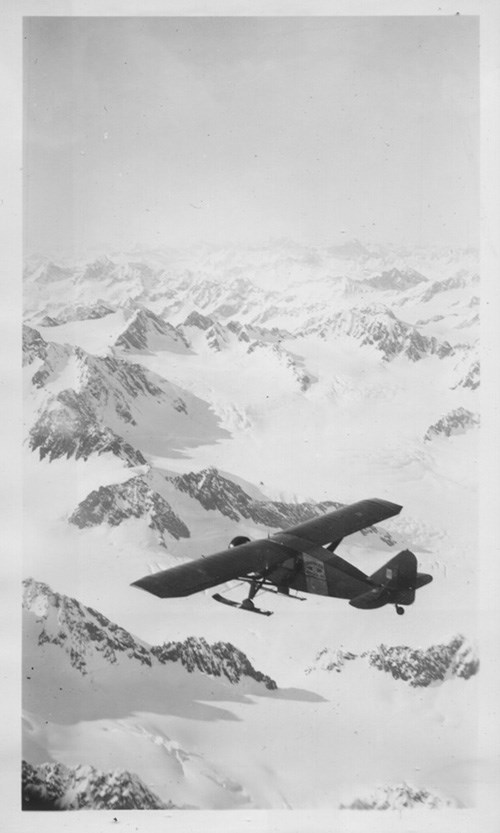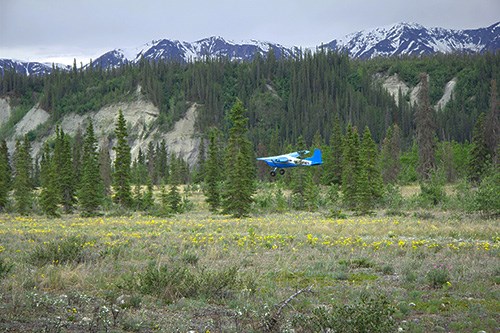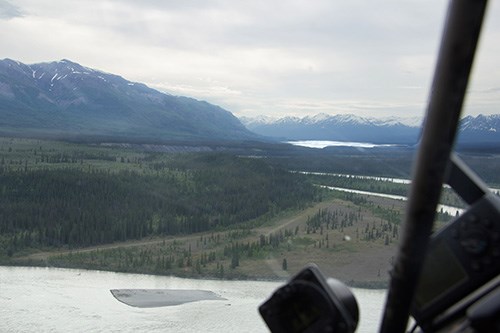Last updated: October 23, 2020
Article
Aviation and Cultural Landscapes of Alaska
There is a saying in aviation: there are old pilots and there are bold pilots, but there are no old bold pilots.
In Alaska, the expression too often rings true, reflective of fast-changing weather, often-improvised landing strips, and in many places, great mountainous terrain. This combination of aviation challenges is found in exemplary form in the Wrangell St- Elias National Park and Preserve, the largest national park where the Wrangells, St. Elias, and Chugach mountain ranges rise to form the heads of the nation’s largest glacial system.
Imagine flying in a small airplane equipped with skis instead of wheels, the destination is a glacier providing access to the mountains. It’s overcast, the light is flat and the boundaries between rock, ice and air are indiscernible - how confident would you be in landing safely?
If you were flying with Bob Reeve in the early days of bush piloting in Alaska, you might be a little nervous, but you should relax as the pilot throws willow boughs out the window to reveal the landing surface – because Bob Reeve did indeed become an old and bold pilot.

NPS Photo (in Ethel LeCount Historical Photos album)
Reeve pioneered techniques of landing on glaciers while flying mountaineers, miners, and their gear to the high country in the Copper River Basin in what was to become Wrangell-St. Elias National Park and Preserve. Such techniques enabled landing Bradford Washburn and climbing partner at Walsh Glacier at the base of 17,150 foot Mount Lucania in 1937, the highest unclimbed mountain in North America at the time.
Aviation became a key player in transportation in Alaska at a time when roads and trails were rough and rail only pierced slivers of the vast territory. Overland travel was extremely difficult and taxing in a country where many routes required slogging through wet, boggy terrain, crossing swift rivers of ice-cold glacial melt water, crossing high mountain passes and glaciers, or waiting for the land and water to stabilize to allow sled travel through bitterly cold winters. Air transportation freed up much time and energy to those seeking access to the remote country.
Upon the arrival of air transportation, journeys that would take many days overland with a pack train of horses could suddenly be completed much quicker. The general paucity of airstrips would necessitate innovative solutions from the pilots, including landing on river bars, open tundra, and glaciers riddled with treacherous and often hidden crevasses.
Some river bars were cleared of large debris to form an airstrip, such as at Hubert’s Landing on the upper Chitina River. Margaret Harrais recounts the landing from her first airplane trip, flown in 1931 by renowned pilot Harold Gillam to reach her and her husband’s mining claims:
The flight to camp occupied but forty minutes. As we sailed along, I was very busy trying to realize that it was the same route I had traveled four times, never in less than five long grueling days, through one danger only to be beset by another of a different kind. In comparison the airplane seemed wonderfully safe, even though we were to make the first landing on the field. The field was home-made without any knowledge of the minimum requirements for that style of plane, and Alaskan winters and glacial streams are sometimes devastating on terrain.

NPS Photo
The airstrips in Wrangell-St. Elias National Park and Preserve represent a regional identity that connected people through mining, community services (such as mail delivery), mountaineering, military efforts (especially during the cold war), tourism, scientific endeavors, hunting, and environmentalism.
Today, numerous airstrips, hangers, cabins, mail shacks, crash sites, a few planes and aviation objects, such as windsocks and antennas remain scattered throughout the region. Some are abandoned, while others continue to be used. Moreover, several properties still maintain structural integrity. They continue to convey qualities representative of the history of aviation in the Wrangell-St. Elias mountain region, which began in 1927. If you visit Wrangell-St. Elias today, there are a number of airstrips available for landing for small craft, and there are experienced “bush pilots” to take you there.

NPS Photo
Documentation of cultural landscapes that contribute to an understanding the role of aviation and the airstrips in Wrangell-St. Elias is on-going, including recent field work for a cultural landscape inventory at Jake’s Bar. Jake's Bar is a small, gravel airstrip with associated cabins that was etched out of a river bar on the Chitina. This continuing work illuminates the way aviation helped shape the imprint of humans in this rugged landscape.
Learn More
- Wrangell-St. Elias National Park & Preserve website
- Pilot Stories at Project Jukebox (Digital Branch of the University of Alaska Fairbanks Oral History Program)
- Aviation and the National Park Service
- What are Cultural Landscapes?
Further Reading
Ringsmuth, K.J. Alaska’s Skyboys: Cowboy Pilots and the Myth of the Last Frontier. University of Washington Press, 2015.
———. At Work in the Wrangells: A Photographic History, 1895-1966. United States Department of the Interior, National Park Service, 2016.
———. "Aviation Properties of Wrangell-St. Elias National Park & Preserve." National Register of Historic Places Multiple Property Documentation Form, 2012.



